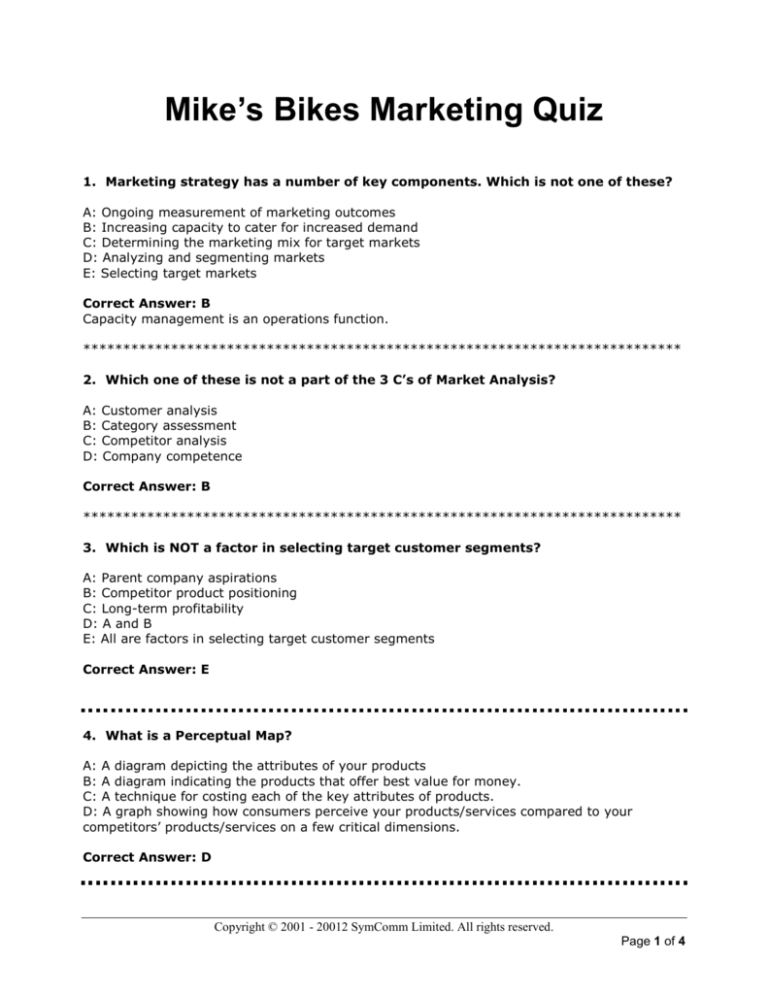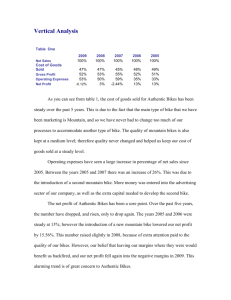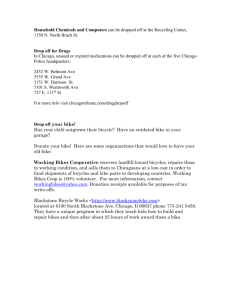
Mike’s Bikes Marketing Quiz
1. Marketing strategy has a number of key components. Which is not one of these?
A: Ongoing measurement of marketing outcomes
B: Increasing capacity to cater for increased demand
C: Determining the marketing mix for target markets
D: Analyzing and segmenting markets
E: Selecting target markets
Correct Answer: B
Capacity management is an operations function.
***************************************************************************
2. Which one of these is not a part of the 3 C’s of Market Analysis?
A: Customer analysis
B: Category assessment
C: Competitor analysis
D: Company competence
Correct Answer: B
***************************************************************************
3. Which is NOT a factor in selecting target customer segments?
A: Parent company aspirations
B: Competitor product positioning
C: Long-term profitability
D: A and B
E: All are factors in selecting target customer segments
Correct Answer: E
4. What is a Perceptual Map?
A: A diagram depicting the attributes of your products
B: A diagram indicating the products that offer best value for money.
C: A technique for costing each of the key attributes of products.
D: A graph showing how consumers perceive your products/services compared to your
competitors’ products/services on a few critical dimensions.
Correct Answer: D
Copyright © 2001 - 20012 SymComm Limited. All rights reserved.
Page 1 of 4
5. Which of the following is NOT a part of Market Segmentation?
A: Listing potential segmentation criteria
B: Considering geographic, demographic, psychographic, and behavioral factors
C: Identifying appropriate distribution channels for reaching consumers
D: Ensuring that proposed segments have distinct needs
E: Sketching perceptual maps
Correct Answer: C
6. There are now 5 P’s of marketing. Which one is the most recent and is not
modeled in Mike’s Bikes?
A: Product – the product/service bundle you are offering
B: Place – the place customers will be able to purchase the product also called distribution.
C: People – the relationship aspects of marketing
D: Promotion – includes advertising, branding, point of sale display, promotional discounts etc
E: Price – the price customers pay for the product
Correct Answer : C
Relationship marketing, also known as People. It is not currently modeled in Mike’s Bikes.
7. Assume that you have a product with the following characteristics: estimated
sales volume 10,000; product cost $160; retailer margin 20%, invested capital
$1.5m. What is the approximate retail price, applying markup pricing of 25%?
A: $291
B: $280
C: $268
D: $250
E: Not enough information
Correct Answer: D
Wholesale price is $160 + (0.25x$160) = $200, retail price would be $200/0.8 = $250
8. Assume that you have an Adventurer bike with the following characteristics:
estimated sales volume 20,000 per year; product cost $110; overhead of $80 per
unit, retailer margin 50%, invested capital $2.4m, expected life cycle of 3 years.
Approximately what retail price should you charge to get a 25% return on
investment?
A: $120
B: $240
C: $360
D: $480
E: None of the above
Copyright © 2001 - 20012 SymComm Limited. All rights reserved.
Page 2 of 4
Correct Answer: D
You need a return of 3m over 3 years, which is $1m each year. So the contribution margin
(gross margin) required is ($1million/20,000) $50 per bike and the wholesale price must be
$50+$110+80=$240 (the sum of return, product cost and overheads). So retail price must be
$480 ($240/(1-0.5).
9. Having spare production capacity, your firm and all competing firms in a Mike’s
Bikes simulation dropped bike prices by 10%. What is the likely outcome for your
firm?
A: Sales units – up, sales revenue – can’t tell, market share – same
B: Sales units – up, sales revenue – up, market share – same
C: Sales units – up, sales revenue – up, market share – up
D: Sales units – up, sales revenue – down, market share – same
E: Sales units – up, sales revenue – down, market share – down
Correct Answer: A
Dropping prices will result in an increase in the number units sold. Depending on how many
more are sold, sales revenue might go up or down. Assuming that the number of units of each
product sold increases by the same proportion and that no other factors (such as product
awareness) change, the market share of all the competitors will remain the same.
10.Assume you are targeting the Adventurer segment. Assume that 30% of
consumers wanting to purchase an Adventurer bike go to department stores and
50% go to bike shops. The margin you are offering means that 60% of
department stores stock your product and 90% of bike shops. Roughly what
distribution coverage of the Adventurer segment do you have?
A: 0.43
B: 0.48
C: 0.50
D: 0.63
E: 0.72
Correct Answer: D
0.3*0.6 + 0.5*0.9 = 0.63
11.Branding and product advertising are two terms used in marketing and
promotion. Which of the statements below would best explain the logical
relationship between these?
A: Branding is usually at the company or product line level and builds a base level of
awareness. Product advertising is more targeted and adds to this effect to generate total
awareness of a product.
B: Branding and product advertising are essentially the same thing.
Copyright © 2001 - 20012 SymComm Limited. All rights reserved.
Page 3 of 4
C: Total awareness of a product is driven by product advertising alone. Branding is quite
independent of this and has no additional effect at the product level.
D: A and C
D: None of the above.
Correct Answer: A
12.A colleague is confused because his sales revenue has fallen even though his
market share (in units) is the same as it was the previous period. Which of the
following is a possible reason for this?
A: Product X’s price was lowered significantly, but was matched by others in the segment.
B: Product X’s price was decreased but no increase in demand resulted.
C: The segment size is decreasing.
D: All of the above
Correct Answer: D
(a)If the price of all products in a segment were lowered by the same amount, each product’s
market share (in units) would remain constant, though total sales revenue would decrease.
(b)If the segment were not price-sensitive, lowering the price would lead to no change in sales
volume or market share (in units) but sales revenue would fall. (c)A shrinking segment would
result in fewer total sales and hence decreased sales revenue, but, all other things remaining
the same, market share (in units) would remain constant.
Copyright © 2001 - 20012 SymComm Limited. All rights reserved.
Page 4 of 4










